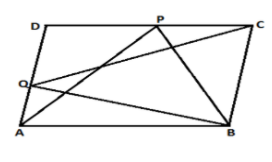
$P$ and $Q$ are any two points lying on the sides $DC$ and $AD$ respectively of a parallelogram $ABCD$. Show that $area\;\left( {\Delta APB} \right) = area\;\left( {\Delta BQC} \right)$.
Answer
576k+ views
Hint:In the solution we will use the concept of parallelogram which states that if the triangle and parallelogram have the same base and parallels then the area of triangle is half of the parallelogram.
Complete step-by-step solution
Given: $P$ and $Q$ are any two points lying on the sides $DC$ and $AD$ respectively of a parallelogram $ABCD$.

Since $\Delta APB$ and parallelogram $ABCD$ are on the same base $AB$ and between the same parallels.
Therefore, $ar\left( {\Delta APB} \right) = \dfrac{1}{2}ar\left( {{\rm{Parallelogram}}\;\;ABCD} \right)$ …..(1)
Similarly,
Since $\Delta BQC$ and parallelogram $ABCD$ are on the same base $AB$ and between the same parallels.
Therefore, $ar\left( {\Delta BQC} \right) = \dfrac{1}{2}ar\left( {{\rm{Parallelogram}}\;\;ABCD} \right)$ …..(2)
From equation (1) and equation (2) we can say that
$area\;\left( {\Delta APB} \right) = area\;\left( {\Delta BQC} \right)$
Note: Here we have make sure of using the concept of parallelogram instead of concept of quadrilateral.So here we can say that when parallelograms have same base as well as same parallels then the area of parallelogram is doubled of the area of triangle.
Complete step-by-step solution
Given: $P$ and $Q$ are any two points lying on the sides $DC$ and $AD$ respectively of a parallelogram $ABCD$.

Since $\Delta APB$ and parallelogram $ABCD$ are on the same base $AB$ and between the same parallels.
Therefore, $ar\left( {\Delta APB} \right) = \dfrac{1}{2}ar\left( {{\rm{Parallelogram}}\;\;ABCD} \right)$ …..(1)
Similarly,
Since $\Delta BQC$ and parallelogram $ABCD$ are on the same base $AB$ and between the same parallels.
Therefore, $ar\left( {\Delta BQC} \right) = \dfrac{1}{2}ar\left( {{\rm{Parallelogram}}\;\;ABCD} \right)$ …..(2)
From equation (1) and equation (2) we can say that
$area\;\left( {\Delta APB} \right) = area\;\left( {\Delta BQC} \right)$
Note: Here we have make sure of using the concept of parallelogram instead of concept of quadrilateral.So here we can say that when parallelograms have same base as well as same parallels then the area of parallelogram is doubled of the area of triangle.
Recently Updated Pages
Master Class 12 Economics: Engaging Questions & Answers for Success

Master Class 12 Maths: Engaging Questions & Answers for Success

Master Class 12 Biology: Engaging Questions & Answers for Success

Master Class 12 Physics: Engaging Questions & Answers for Success

Master Class 8 Maths: Engaging Questions & Answers for Success

Class 8 Question and Answer - Your Ultimate Solutions Guide

Trending doubts
Write a letter to the principal requesting him to grant class 10 english CBSE

Which of the following does not have a fundamental class 10 physics CBSE

State and prove the Pythagoras theorem-class-10-maths-CBSE

What is the full form of POSCO class 10 social science CBSE

State BPT theorem and prove it class 10 maths CBSE

A Gulab jamun contains sugar syrup up to about 30 of class 10 maths CBSE




